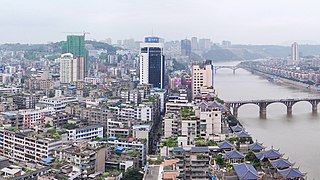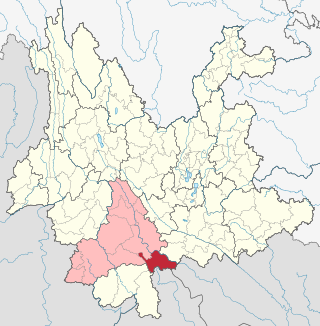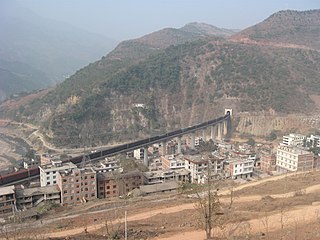
Guiyang is the capital of Guizhou province of the People's Republic of China. It is located in the center of the province, situated on the east of the Yunnan–Guizhou Plateau, and on the north bank of the Nanming River, a branch of the Wu River. The city has an elevation of about 1,100 meters (3,600 ft). It has an area of 8,034 square kilometers (3,102 sq mi). At the 2020 census, its population was 5,987,018, out of whom 4,506,134 lived in the six urban districts.

Yibin is a prefecture-level city in the southeastern part of Sichuan province, China, located at the junction of the Min and Yangtze Rivers. Its population was 4,588,804 inhabitants, according to the 2020 census, of whom 2,158,312 lived in the built-up area comprising three urban districts.

Luzhou (simplified Chinese: 泸州; traditional Chinese: 瀘州; pinyin: Lúzhōu; Sichuanese Pinyin: Nu2zou1; Luzhou dialect: ), formerly transliterated as Lu-chou or Luchow, is a prefecture-level city located in the southeast of Sichuan Province, China. It is also known as the "Liquor City" (酒城). It was named Jiangyang (simplified Chinese: 江阳; traditional Chinese: 江陽; pinyin: Jiāngyáng) until the Northern and Southern dynasties. Situated at the confluence of the Tuo River and the Yangtze River, Luzhou has been Sichuan province's largest port in both size and output since Chongqing's separation from Sichuan in 1997. As of the 2020 Chinese census, its population was 4,254,149. Of these, 1,241,273 lived in the built-up (or metro) area made of Jiangyang and Longmatan districts, as Naxi district is not conurbated yet. Luzhou borders Yunnan, Guizhou and Chongqing provinces. As the only geographic junction of the four provinces, it was an important port location in ancient China. After the PRC was founded in 1949, Luzhou became the capital of southern Sichuan province. In 1983, Luzhou was upgraded to prefecture-level city status.

Guangyuan is a prefecture-level city in Sichuan Province, China, bordering the provinces of Shaanxi to the northeast and Gansu to the northwest. The city has a population of 2,305,657 as of the 2020 census.

Zhaotong is a prefecture-level city located in the northeast corner of Yunnan province, China, bordering the provinces of Guizhou to the south and southeast and Sichuan to the northeast, north, and west.

Qujing is a prefecture-level city in the east of Yunnan province, China, bordering Guizhou province to the east and the Guangxi Zhuang Autonomous Region to the southeast; thus, it was called "Key between Yunnan and Guizhou" (滇黔锁钥) and "Throat of Yunnan" (云南咽喉) in the past. It is part of the Central Yunnan Metropolitan Region plan (滇中城市群规划) in effect for 2016–49. Its administrative population is 6,047,000 according to a 2015 estimate, of whom, 1,408,500 reside in the metro area, which contains Qilin District, Zhanyi District and Malong District. During the 11th National Five-Year Plan period, the government of Qujing planned to develop the city into the "big city at the origin of the Pearl River" (珠江源大城市) in the following decades, including increasing the built-up urban area to past 100 km2 (39 sq mi) and the urban population to surpass 1 million by 2020, the second in Yunnan, after Kunming.

Duyun is the capital of Qiannan Buyei and Miao Autonomous Prefecture in Guizhou province, China.

Bijie is a prefecture-level city in northwestern Guizhou Province, China, bordering Sichuan to the north and Yunnan to the west.

Jiangcheng Hani and Yi Autonomous County is an autonomous county under the jurisdiction of Pu'er City, in southern Yunnan, China, bordering Laos and Vietnam to the south, making it the only county in the province to border more than one country. By road, its seat, the town of Menglie (勐烈镇), is 520 km (320 mi) from Kunming and 145 km (90 mi) from Simao District, the municipal seat of Pu'er.

Jingdong Yi Autonomous County is an autonomous county in the west-central part of Yunnan Province, China. It is the northernmost county-level division of the prefecture-level city of Pu'er.

Jinggu Dai and Yi Autonomous County is an autonomous county under the jurisdiction of Pu'er City, Yunnan Province, China.

Zhaoyang District is the only district and the seat of the city of Zhaotong, in the northeast of Yunnan Province, China. It borders the provinces of Guizhou to the southeast and Sichuan to the west.

The transport infrastructure of Yunnan is served by numerous transport modes, and forms an integral part of the structure Yunnan Province and the Southwest of China. Yunnan is served by several civilian airports and a major highway and rail network. The province is served by a network of bus routes that radiates from the capital city, Kunming.

Yuanshi County is located in the southwest of Hebei Province, North China, 40 kilometres (25 mi) to the south of Shijiazhuang, the provincial capital. Yuanshi County borders Gaoyi County to the south, Zhao County and Luancheng District to the east, Jingxing County to the west and Luquan District to its north.
Guantao County is a county of southern Hebei province, China, bordering Shandong's Guan County and Linqing to the east across the Wei Canal (卫运河). It is under the administration of Handan City, and has a population of 320,000 residing in an area of 456 km2 (176 sq mi). Jinan lies 160 kilometres (99 mi) to the east, Handan 75 km (47 mi) to the west, and Beijing 420 km (260 mi) to the north, and the county is served by G22 Qingdao–Lanzhou Expressway and China National Highways 106 and 309. The area was formerly part of Shandong Province.

The Neijiang–Kunming railway or Neikun railway, is a single-track railroad between Neijiang and Kunming in Southwest China. The line runs 872 km (542 mi) from Neijiang in Sichuan province to Kunming in Yunnan province through western Guizhou province. The Neikun Line was built in three sections. The northern section, from Neijiang to Anbian township of Yibin and 140 km (87 mi) in length, was built from 1956 to 1960. The southern section from Kunming to Meihuashan station, near Liupanshui in Guizhou, and 370 km (230 mi) in length, was built from 1960 to 1965 and became the westernmost segment of the Guiyang-Kunming railway. The middle section between Anbian and Meihuashan through Zhaotong and 358 km (222 mi) in length was built from 1998 to 2001. Major cities and towns along route include Neijiang, Zigong, Yibin, Shuifu, Zhaotong, Weining County, Xuanwei, Qujing and Kunming.

Chengdu-Guiyang high-speed railway is a major trunk high-speed railway between the provincial capitals of Chengdu, Sichuan and Guiyang, Guizhou via a small section traversing north east Yunnan province. It was selected for construction under the 11th Five Year Plan set by the Chinese Government. Construction started in 2010 and was expected to be completed by 2014. The northern section of this line between Chengdu and Leshan forms the southern part of the operational Chengdu–Mianyang–Leshan intercity railway.




















